Tweezers and Harami Candlestick Pattern are double candlesticks. Appearance of this Candlestick Pattern at the end of Trend, shows reversal. Always wait for confirmation candles.
Let us look at each in detail with examples
Tweezers candlestick pattern
The Tweezers are two or more candlesticks with matching highs or lows. They are normally spotted at an extended uptrend or down trend signifying a reversal in either of the trends.
The first candle of a tweezers is the same as those in the current trend. The second candlestick is opposite of the current trend.
For example if price is going up, then the first candlestick should be bullish(Blue) and the second candle, bearish(Red).
Similarly, If price is going down, the first candle should be bearish(Red) while the second candlestick is of the opposite trend(Blue).
Unlike in other candlestick pattern where the body is important, with tweezers, the highs and lows are the most important.
Tweezer tops must have same highs while tweezers bottoms must have same lows/bottoms. Without wasting time lets now take a look at an illustration below.
Tweezers Tops and Bottoms
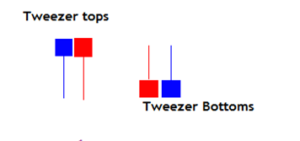
Tweezers Bottoms
The Tweezers bottoms appears at the end of an extended downtrend. Therefore, they are bullish reversal patterns. They have real bodies, shadows or a doji and must have the same lows/bottoms.
The shadows of the candlesticks are of the equal length therefore have equal lows.
For the tweezers bottoms, a bearish candlestick forms first with a moderate shadow below. The next candlestick is bullish with equal body length and shadow sharing the same lows as the first candlestick
When the tweezer bottoms appear at the bottom of a down trend, its a signal that the trend is about to reverse.
The formation of another bullish candlestick is a good confirmation to consider before you take a buy position. Tweezer bottoms are also relevant when at support.
Tweezers tops
Tweezers tops is the opposite of the bottoms. It forms when the highs of two or more candlesticks match.
Tweezers tops normally appear at the top of an extended uptrend.
The first candlestick of tweezers tops is bullish and the second candlestick is bearish sharing the same high/top. It signals a bearish reversal pattern.
The Tweezers tops are composed of real bodies, shadows or a doji. Both candlesticks have either equal highs or tops.
What does a tweezers Top pattern on a chart mean?
When price is moving up, the formation of tweezers tops shows that buyers tried as much as possible to push prices high.
But ended up closing near the open. The sellers appeared, opened at the same level as the previous close and pushed prices back closing as low as the open.
The formation of the second bearish candlestick that has the same high as the bullish candlestick.
When it closes at the same point as the open of the first candlestick, it shows great indecision and equal power in the market.
This may lead to a change in trend.
The formation of a large bearish candlestick after the tweezer tops becomes a confirmation that the bears/sellers have become stronger in the market. Hence a likelihood of change in trend.
trading tweezers and harami pattern on Chart
Tweezer tops is shown below on the chart.
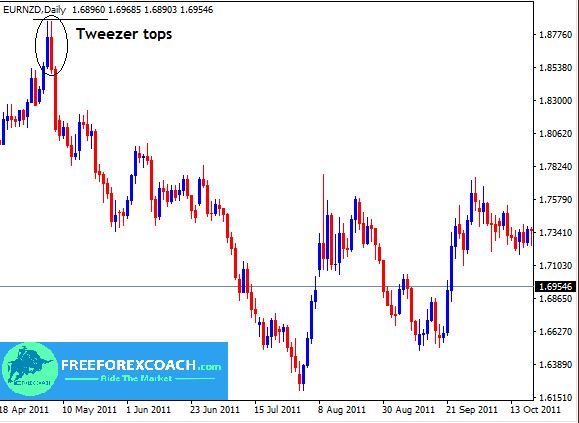
The chart above shows an uptrend followed by a tweezers tops.
If you can take a good look on the above chart you will see that the two candlestick patterns have the same highs. The formation of a large bearish candlestick after the pattern gave a confirmation for a sell signal.
At this point we expect a probable change in the trend direction to the downside.
What does a tweezers bottom pattern on a chart mean?
When price is moving down, the appearance of tweezers bottoms signifies, that there is fight for power between the buyers and the sellers (great indecision).
The sellers try to push prices as low as possible but closed new the open. The buyers come in opened at the same level as the previous close and push the prices back up but closed near the open.
Formation of the second bullish candlestick having the same body and same shadow size as the low signifies great indecision in the market.
The formation of a next big bullish candlestick will become the confirmation of the change in the trend.
Take a look at the chart below.
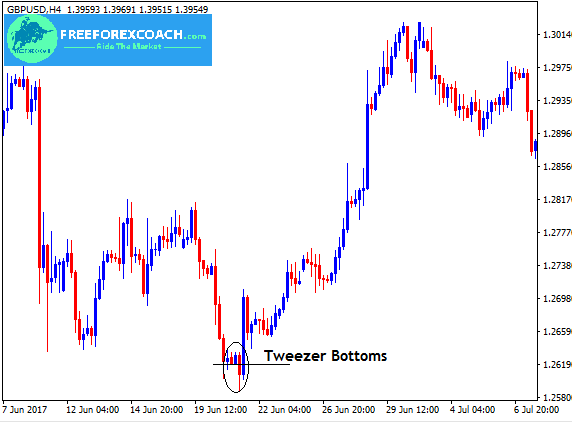
From the above chart, the 2 candlesticks share the same low and same high.
The close of the first candle is equal to the open of the second candle.
The formation of a large bullish candlestick gave the confirmation for a change in trend direction.
The Harami candlestick pattern
The harami is the opposite of the engulfing pattern.
It is sometimes called the harami cross.
The first candlestick is large and the second is small.
Almost the size of spinning tops or a doji. There are 2 types;
Bullish Harami
These are two candlestick patterns that appear at the bottom of a strong downtrend.
It’s a combination of a large bearish candlestick with a small bullish candlestick sometimes a doji.
A bullish Harami is a bullish reversal pattern
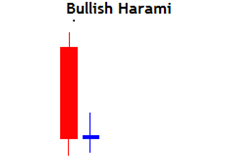
When this forms on a declining trend the formation of the small body or a doji shows the point of indecision in the market.
The next candlestick to form gives a confirmation.
The Bearish Harami
The bearish harami forms at the end of an uptrend with a large bullish candlestick and a small candlestick.
It is a bearish reversal pattern.
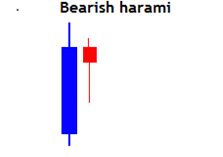
A small bearish candlestick forming after a large bullish candlesticks shows loss of power by the bulls. It is a sign of indecision. The next candlestick gives a confirmation for trend reversal.
The appearance of a harami after a long down trend can lead to change in trend direction to the upside. When in an uptrend, it can lead to trend reversal to the downside.
This is illustrated as below. Take a look.
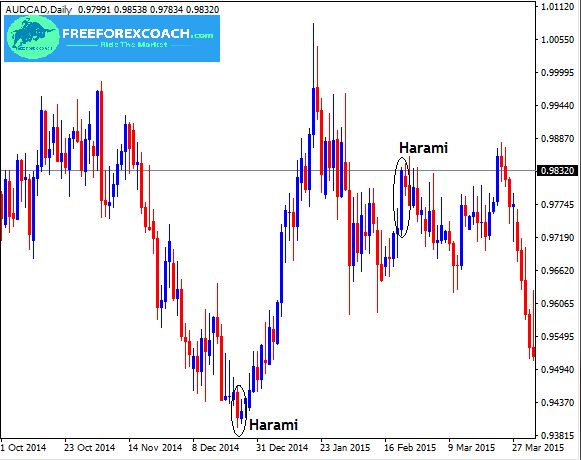
Simple Tips on Tweezers and Harami candlestick pattern
Tweezers
- The Tweezers are two or more candlesticks with matching highs or lows.
- They are normally spotted at an extended uptrend or down trend signifying a reversal in either of the trends.
- The first candle of a tweezers is the same as those in the current trend. The second candlestick is opposite of the current trend.
- Tweezer tops must have same highs/tops while tweezers bottoms must have same lows/bottoms.
Harami
- The harami is the opposite of the engulfing pattern. The first candlestick is large and the second is small.
- A bullish Harami is a bullish reversal pattern while a bearish Harami is a bearish reversal pattern.
To successfully trade tweezers and harami pattern, always wait for the formation of the confirmation candlestick before buying/selling.
How Does Greed Impact your Forex Trading Success?
There are several ways greed can impact your Forex trading success. Firstly, greed can make you abandon your well crafted trading strategy in favor of impulsive and speculative actions. Instead of adhering to predetermined entry and exit points based on technical or...
-
- Topic
- Voices
- Last Post



